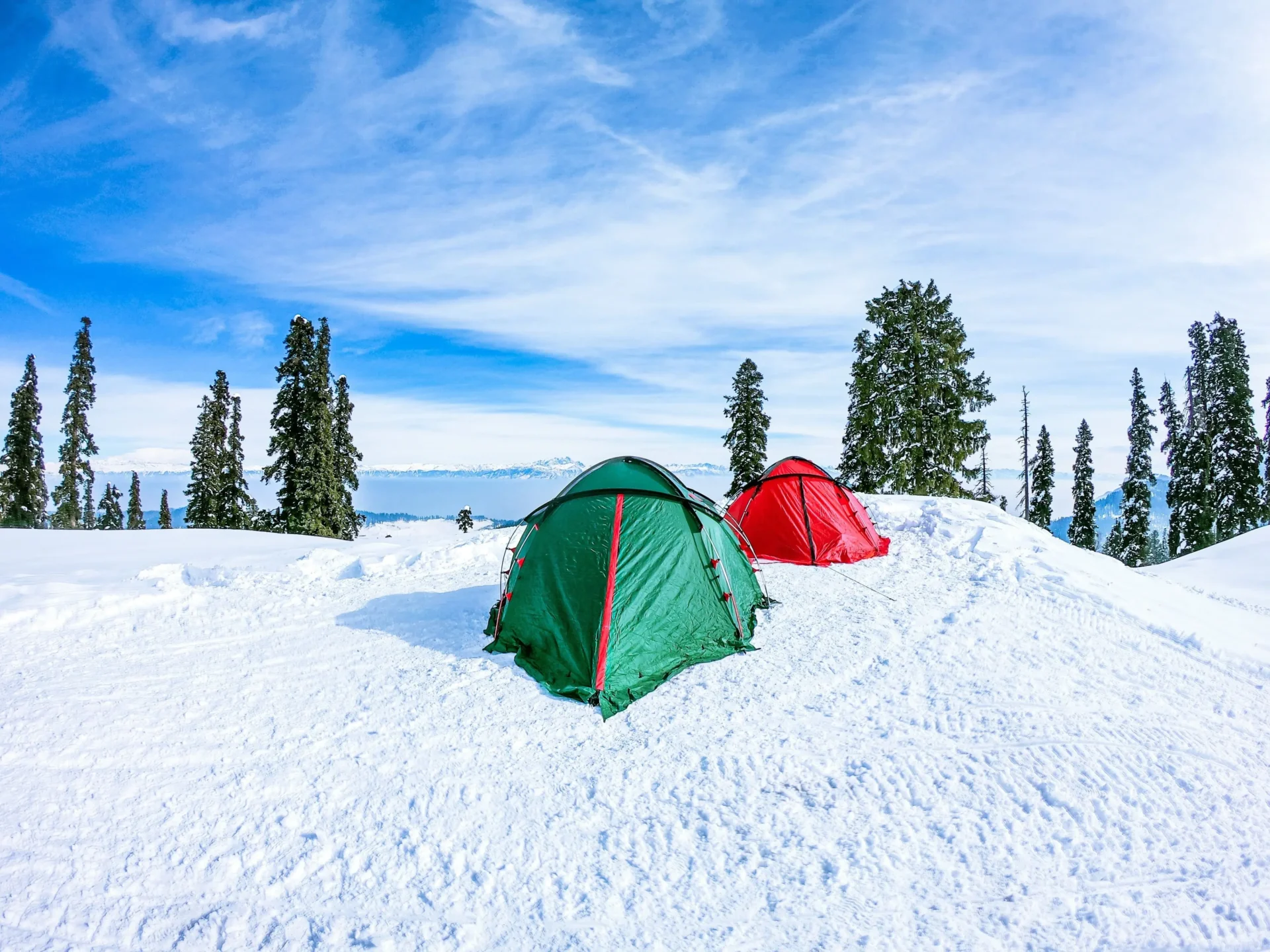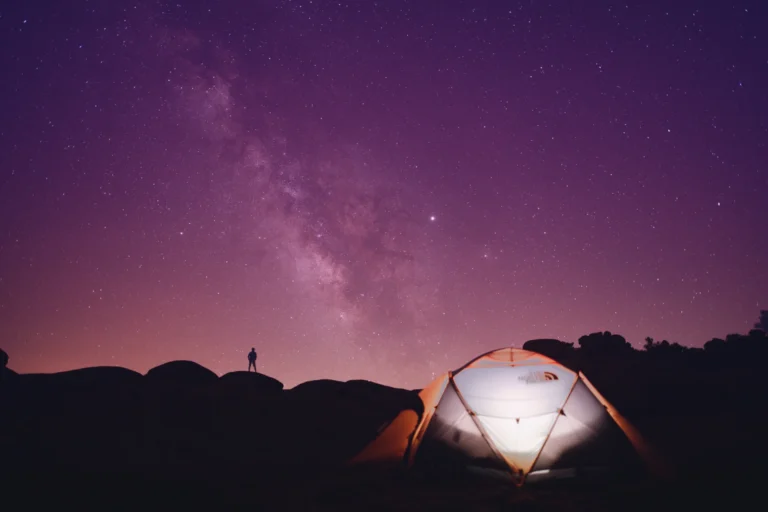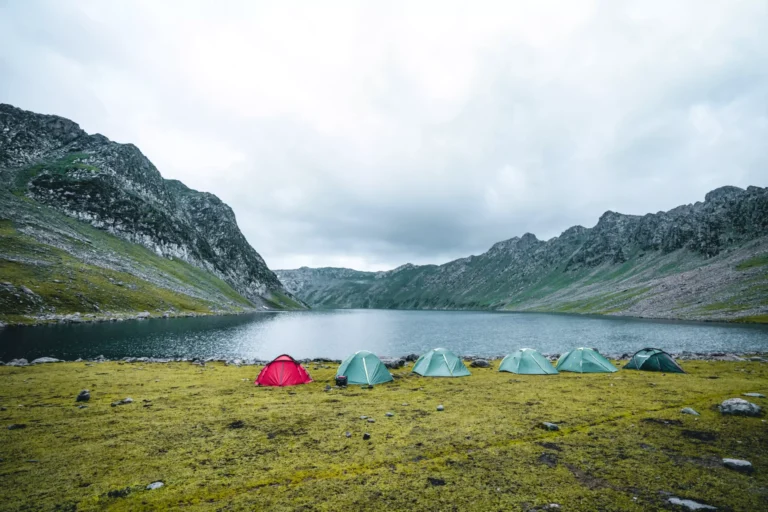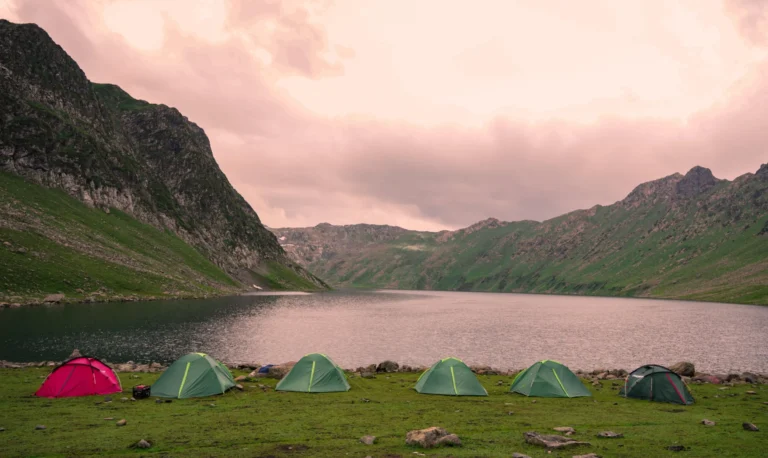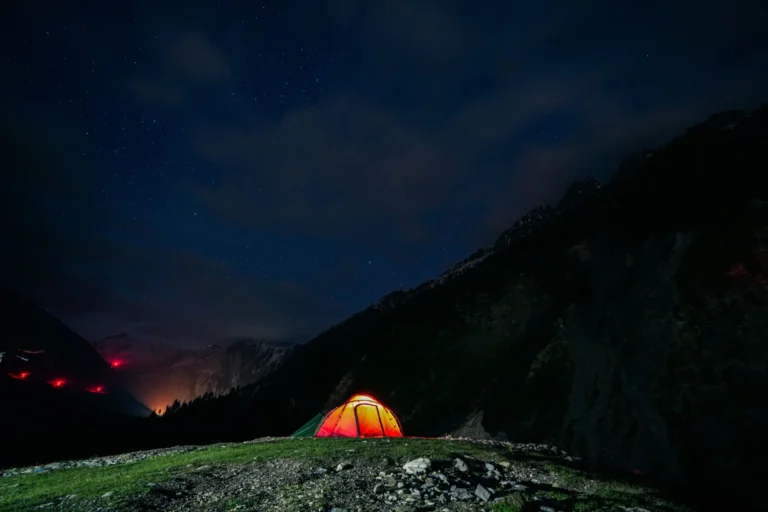The area is covered in a magnificent tapestry of snow as ice crystals sparkle in the winter sun. An incredible experience of stunning landscapes and a peaceful atmosphere can be had while camping in the snow. However, it also presents challenges and necessitates careful planning, specialized equipment, and knowledge to ensure a safe and enjoyable trip.
This blog will unveil the secrets to crafting an immersive winter camping experience where every moment is etched with awe and wonder. We will guide you through the essentials of how to camp in the snow and provide you with valuable tips and tricks for an unforgettable winter camping experience.
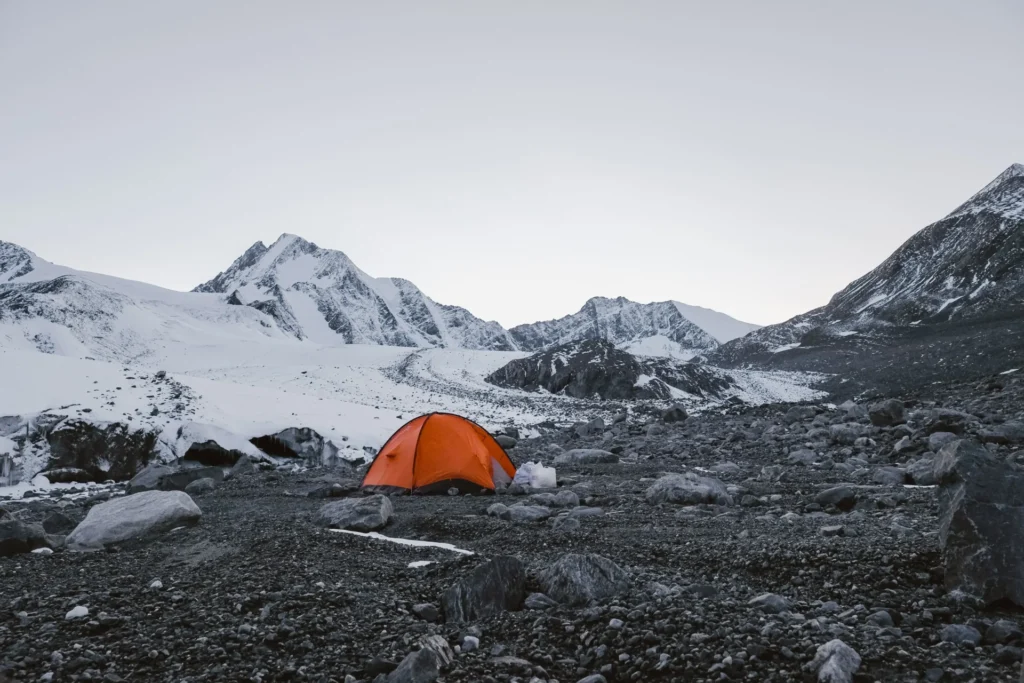
How to Camp in the Snow?
Let’s embrace the excitement and charm of camping in the snow but remember that it requires careful planning and preparation to guarantee your safety and well-being. Here, we present you with some valuable tips for your snowbound camping trip:
1) Choose the Right Gear
Invest in a resilient four-season tent fortified against nature’s icy fury. Make sure to wrap yourself in a cozy sleeping bag, a warm haven. Cushion your rest with an insulated sleeping pad, blocking the cold from below, and adorn yourself with layers of clothing, shielding against winter’s frosty hug.
2) What kind of tent is ideal for snow camping?
Four-season or mountaineering tents are best for snow camping. These tents can endure severe winds and snowfall. Durable materials, including ripstop nylon, a robust frame, and reinforced seams, offer stability and weather protection. You
Four-season tents have steeper slopes to shed snow and vestibules for kit storage and ventilation to reduce humidity. Choosing a tent camp in snow requires careful consideration of various criteria, including the number of campers, the tent’s weight, waterproof features, roof lines at the top, the difficulty of setting it up, and the general longevity of the tent.
Your tent must be kept toasty warm when taking a winter camping trip. Keep reading for additional ideas on how to stay warm winter camping.
3) Find the right location
Snow camping requires careful site selection. Look for a flat area away from hazards like trees with heavy snow loads or avalanche-prone slopes. To establish an appropriate foundation for your tent, remove any snow from the area. Safety should come first, so make sure you carefully remove all snow from the chosen location and build an adequate tent foundation.
- Research the weather conditions of your selected site and monitor any alerts or warnings from weather specialists.
- Find a place that has protection from the weather and stay away from any regions where there is a chance of avalanches.
- Don’t pitch your tent near the base of a hill, as that’s where chilly air troughs like to form, or on top of a mountain, as it can be a wind tunnel.
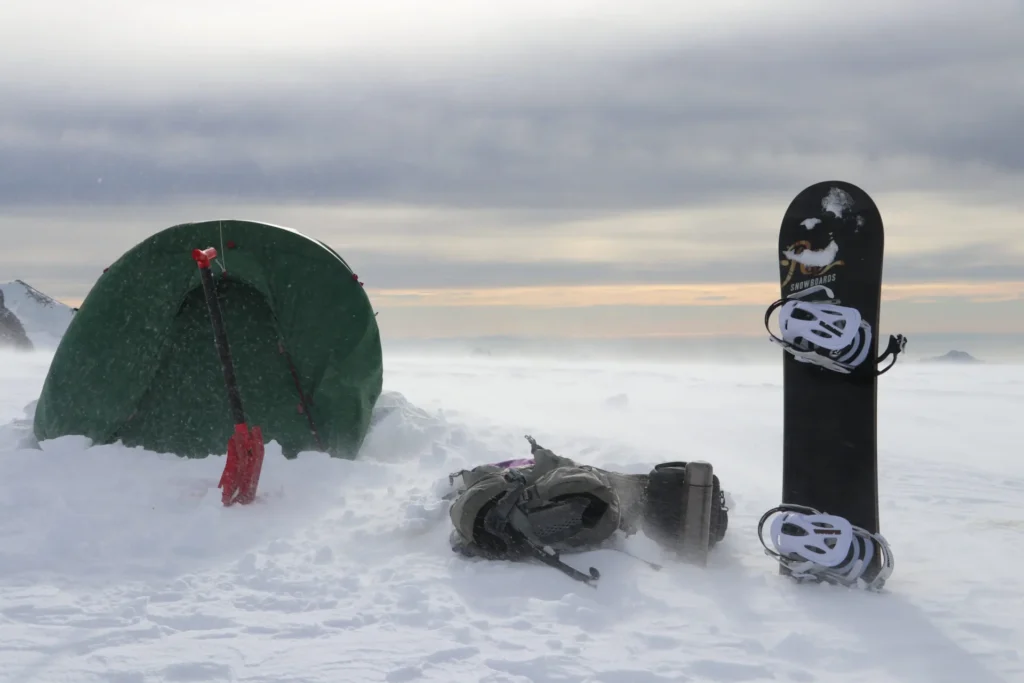
4) Use an Insulated sleeping bag
A warm sleeping bag is essential for winter camping. Ensure your sleeping bag can endure cold temperatures and has a “temperate rating.” Proper insulation is necessary for warmth. Cold weather sleeping bags include lots of goose down or synthetic insulation to keep you warm and can keep you warm in sub-zero temperatures.
Inflatable mats, especially those filled with down, offer additional insulation and can be placed on top of a foam mat for even more warmth. This ensures nighttime comfort and safety. Before your journey, check weather forecasts and make sure your tent and gear are suitable. Newbies in winter camping should also stay on regular trails.
5) Stay hydrated and plan high-energy foods
Cold weather requires staying warm. Prepared winter camping may be enjoyable. It is better to drink lots of water throughout the day to prevent dehydration in the cold. Keep your energy up by eating healthy meals high in calories, as your body will burn more calories and need more of them to keep warm and keep going.
Pack high-energy foods like almonds, granola bars, and dried fruits, and go for dehydrated meals that can be quickly reconstituted with hot water. Bring a thermos full of hot liquids and some fuel for your portable burner. Be sure to have extra water or plan to melt snow for a drink, but you’d better clean it first. Insulated water bottles are a must-have to avoid having your beverages freeze solid.
6) Warm Clothing
Layer your clothing to keep warm and keep the cold out. Put on a waterproof outer layer, an insulating mid layer, and a moisture-wicking base layer to stay dry in the rain.
Bringing a thermal base layer, an insulating mid-layer, and a waterproof outer shell is essential preparation for cold weather. Go out with a blanket, sleeping bag, boots, jackets, waterproof gloves, winter cap, and insulating socks. Use wool or polyester underwear garments to stay warm. To prevent cold and wetness throughout the night.

Avoid the need to urinate or flush while you’re out and about. If you have access to a bathroom, your body will make more of an attempt to maintain fluid levels. Because of this, you could become chilly when camping.
7) Snowshoes or skis
If you want to know how to keep feet warm winter camping, choose insulated, waterproof boots with high grip. Gaiters for hiking are also helpful for preventing snow from entering footwear (winter-specific equipment, such as snowshoes or crampons for navigating snow and ice, an ice axe for climbing, and a shovel for preparing a campsite in the snow).
Skis or snowshoes will make it easier to get around in the thick snow and discover your surroundings, but they will only work in certain conditions.
8) Bring a Cooking appliance
Take a stove, a portable burner or additional cookware that can be used in low temperatures. Extra fuel should be brought if it burns more quickly in the cold.
9) Emergency kit
Camping in the snow presents obstacles and hazards, so it’s essential to be prepared with an emergency pack. A first aid kit with bandages, painkillers, antiseptic wipes, and any other drugs you may need is necessary.
In addition to the usual first-aid items, you should include hand warmers, blister treatment, and cold packs in case of injuries sustained in the cold.
10) Build a snow wall or windbreak
Construct a snow wall using shovels or other equipment to protect your campsite from wind and drifting snow. If you do this, your camp space will be warmer and more protected from the elements.
11) Keep your devices charged
SunPower is available even in winter. Find a cold-weather solar charger. To enhance its efficiency, position it in the sun and tilt it.
Bring additional batteries, keep them warm in your sleeping bag or jacket pocket, and only use them when needed. Cold temperatures quickly deplete gadget batteries.
Is it safe to camp in the snow?
Winter camping is thrilling and fun, but safety should be considered first. Is snow camping safe? Snow camping is safe and fun with the right gear and precautions. However, it has challenges. Avalanches, harsh weather, and freezing temperatures necessitate safety precautions.
A four-season tent, heated sleeping bags, insulated pads, and layered clothes are essential cold-weather gear. Snow camping requires information of winter survival strategies, hypothermia and frostbite side effects, and neighborhood climate forecasts. Security, planning, and mindfulness will guarantee a fun and secure winter camping trip.
Extra Tips for Snow Camping
Everyone wants to know how to stay warm while winter camping. Here are some useful tips for winter camping:
- Avoid being unprepared for the dark mornings by bringing a flashlight or headlamp in case you need one.
- Wool is a good insulator and thermal insulator. The base layers of clothing should not be cotton but synthetic or merino wool.
- Bring fire starters, wood, paper, and a spare lighter to build a fire.
- When the snow melts, dig a pit to help support your fire. To keep warm while you sleep, insert a liner into your sleeping bag.
- Tent and sleeping bag condensation from snowfall and other weather conditions. When you return from your trip, unpack everything and give it a thorough drying out. Care for a tent in this manner will keep it mildew-free.
- You’ll need to melt snow to get water, so stock up on gasoline. In subzero conditions, white gas stoves perform admirably.
- Bring plenty of batteries and illumination options like lanterns, headlamps, and candles.
- Instead of carrying water on your trip, you may lighten your weight by bringing water treatment and melting snow.
- The cold causes a quicker discharge rate in all electronic devices. Try out lightweight and compact power packs.
- You may avoid sitting on the snow by bringing camp chairs, blankets, or your closed foam pad. You can keep your buns from freezing by doing this.
Conclusion
Snow camping may be a wonderful, risk-free, and memorable experience if you prepare well. It gives a rare chance to interact with nature in a beautiful winter paradise. With the right preparation and the right gear, you may confidently start on this trip. Always prioritize safety, monitor the weather, and be ready for anything. Enjoy skiing and the tranquility of the snowy scenery. Snow camping is magical, whether you’re stargazing or being embraced by a campfire. Remember the essentials and bundle up before venturing out into the winter wonderland! Stay warm, safe, and make lasting memories

